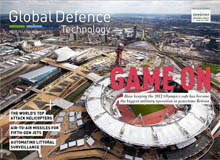
The 2012 London Olympics is the largest and most expensive security operation in recent British history, involving 10,000 police officers and 13,500 members of the armed forces at a cost of around £1bn. As the UK’s capital gears up to meet potential threats that could come from anywhere, including cyberspace, we round up the technology used to keep the Games safe, and ask a cybercrime expert why cyber security is just as important as physical security.

Discover B2B Marketing That Performs
Combine business intelligence and editorial excellence to reach engaged professionals across 36 leading media platforms.
To read your free copy of this issue, click here.
Also in this issue
Army
Helicopter gunships have become almost instantly identifiable following their frequent use in recent combat zones such as Iraq and Afghanistan. We identify the top multirole attack helicopters being used around the world, and take a closer look at the US Army’s Apache helicopter and the Eurocopter Tiger built for the French and German Armies.
Read more in the army section of this issue.
Air force
The potential danger to today’s fighter aircraft has grown as unmanned drones and advanced surface-to-air missiles feature alongside enemy pilots in aerial warfare. We take a look at the latest air-to-air missiles, which are an essential element for fifth-generation fighters. We also feature the A-Darter air-to-air missile, which is being developed in South Africa and is expected to be ready for production next year.

US Tariffs are shifting - will you react or anticipate?
Don’t let policy changes catch you off guard. Stay proactive with real-time data and expert analysis.
By GlobalDataRead more in the air force section of this issue.
Navy
Underwater communication is restricted by the depth at which a vessel can receive information and the speed at which it can travel. We explore a new technique called Quantum Key Distribution, which uses the law of physics to offer secure exchanges without sacrificing speed or depth. We also investigate how a networked system of automated vehicles can be used to protect vast stretches of coastline.
Read more in the navy section of this issue.
Next issue preview
Advances in neuroscience offer the potential of mind-controlled weapons and performance enhancement, but are extra-sensory enhanced warfare techniques mere science fiction? We ask the experts how progress in the understanding of the human mind could help to protect future soldiers.
We also look at cutting-edge spatial awareness technology for soldiers, report on progress of the US Air Force’s Deployable Radar Approach Control system, and investigate the Asian race for early warning missile detection capabilities.
Moreover, we catch up with the latest developments in the world’s aircraft carrier programmes and find out how the UK and Argentine naval forces have developed since the Falklands conflict.
Subscribe for free to receive future issues of Global Defence Technology.
Digital magazine FAQ
The digital magazine is viewable on any computer with Flash Player installed. It is also viewable on mobile devices, iPhones and iPads though some features and videos will be disabled.
View the archive of past issues.






